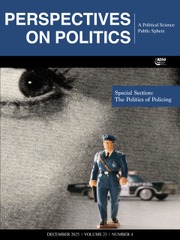In recent decades, as the vice presidency has grown in importance, the office has received increasing academic attention from a variety of different analytical perspectives. In Emerging from the Shadows, Richard Yon focuses on the vice-presidential role in governance. Operating from a qualitative, institutional perspective, Yon builds on two groundbreaking studies—Joel Goldstein’s The White House Vice Presidency (2016) and Paul Light’s Vice-Presidential Power (1984)—which explain how the modern vice presidency came into being during the tenure of Walter Mondale (1977–1981) and how incumbents have exercised influence on executive-branch decision making ever since.
Beginning by carefully distinguishing between influence and power, Yon posits that vice presidents typically exercise the former, which he views as more “indirect” and “contingent” than the latter (pp. 7–8, 15–24, 258). To this end, Yon introduces a four-pronged analysis to examine how modern vice presidents exercise influence. First, his approach focuses on interpersonal factors between the President and Vice President, which include their respective temperaments, outlooks, and abilities. A good personal and professional bond of this type, the author asserts, is necessary but insufficient to establish the Vice President as a significant player in the West Wing. A second consideration entails the political and policy context that frames the officeholder’s tenure. A third factor is the institutional setting, which involves the personnel and management of the White House, the Vice President’s office, and the executive branch as a whole. A final variable centers around electoral circumstances, which implicate the Vice President’s role in the administration’s reelection effort or the officeholder’s own campaign for the White House. These four factors are not static, Yon emphasizes; they fluctuate. Despite these ebbs and flows, he concludes that a Vice President’s influence inevitably wanes over time.
Turning to case studies, Yon begins by applying these four criteria to Nelson Rockefeller’s time in office as it helped set the stage for Mondale’s trailblazing term. Next, Yon turns to Cheney’s tenure, because it marks the apogee of the office’s impact on governance. In his final substantive chapter, the author more briefly examines the vice presidencies of Mondale, George H.W. Bush, Dan Quayle, Al Gore, and Joe Biden.
The framework for evaluating vice-presidential influence that Yon offers is crisp and thoughtfully constructed, and it merits a place in the sun alongside Light’s own formulation on the subject. It is, therefore, not surprising that Yon’s theory, first articulated in his noteworthy dissertation, has already been cited with approval in the field. (See, for example, Karine Prémont’s recent article for Presidential Studies Quarterly, “The president and the vice president: Different types of partnerships for a unique power couple.”)
The second part of Yon’s thesis—that vice-presidential influence necessarily declines during the course of an administration—is thought provoking. As he points out, the nation’s two most consequential officeholders—Gore and Cheney—both saw their standing erode over time. In fact, Yon’s thesis was reaffirmed when Vice President Mike Pence refused to conspire with President Donald Trump to overturn the 2020 election results, effectively ending their relationship and the Vice President’s standing within the White House. (The relationship between President Joe Biden and Vice President Kamala Harris apparently deteriorated as well after the 2024 general election; whether that resulted in her influence lessening is less clear).
Like any new important academic contribution, Yon’s four-part construct paves the way for further exploration, analysis, and potential expansion by others. The same is true of his theory of vice-presidential decline. Is the asserted diminution of vice-presidential impact more pronounced with two-term vice presidents than those serving only one? Does the “outsider-insider” dynamic—which involves a President with little or no national governing experience and a Vice President with an extensive Washington background—affect the potential lessening of vice-presidential sway? Are there broader lessons to be learned from the examples of Rockefeller, Mondale, and Gore who voluntarily chose to reduce their own participation and influence in White House activities?
Throughout Emerging from the Shadows, the breadth of Yon’s learning is on full display and his research is broad, deep, and varied. It includes not only a careful canvassing of archival sources from the Ford, Rockefeller, Carter, Mondale, Reagan, and George H.W. Bush papers but also more than seventy interviews, including with former vice presidents (i.e., Mondale, Quayle, Cheney), Cabinet secretaries, and White House staffers.
On the whole, the book’s shortcomings are few and at the margins. First, the “rule” Yon offers about the inevitable erosion of vice-presidential influence could be seen to be somewhat overstated. For instance, Bush’s standing as Vice President does not seem to have clearly waned in the later stages of the Reagan administration. Similarly, there appears to be little indication that Quayle’s low stature at the outset of his vice presidency dropped even further over time. Second, since one of the work’s premises involves the concept of influence and its relationship to power, perhaps greater recognition and discussion of the Vice President’s actual power would have been in order. Indeed, the last two vice presidencies were marked more by formal exercises of authority than informal influence (e.g., Pence’s actions presiding over the electoral vote count and Harris’s record-setting 33 tie-breaking votes in the Senate). Finally, the rationale for the nonchronological order of the chapters—starting with Rockefeller, jumping to Cheney, and then bunching Mondale, Bush, Quayle, Gore, and Biden together in a final segment—seems a bit strained.
Cavils aside, Emerging from the Shadows is a highly commendable work of scholarship. By introducing an insightful new four-tiered approach to analyzing vice-presidential influence and drawing attention to the tendency of a Vice President’s standing to decline over time, Yon has contributed to a more refined understanding of the second office in the realm of governance. For scholars of the presidency and vice presidency, Yon’s book is not to be missed.

